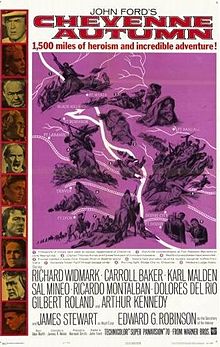- Cheyenne Autumn
-
Cheyenne Autumn
Theatrical release posterDirected by John Ford Produced by John Ford
Bernard SmithWritten by Mari Sandoz (non-fiction history)
Howard Fast
(novel, uncredited)
James R. WebbStarring Richard Widmark
Carroll Baker
James Stewart
Dolores del Río
Edward G. Robinson
Karl MaldenMusic by Alex North Cinematography William H. Clothier Editing by Otho Lovering Distributed by Warner Bros. Release date(s) October 3, 1964 Running time 154 minutes Language English Cheyenne Autumn is a 1964 western starring Richard Widmark, Carroll Baker, James Stewart, and Edward G. Robinson. Regarded as an epic film it tells the story of a factual event, the Northern Cheyenne Exodus of 1878-9, although it is told in 'Hollywood style' using a great degree of artistic license. The film was the last western to be directed by John Ford, who proclaimed it an elegy for the Native Americans who had been abused by the U.S. government and misinterpreted by many of the director's own films. With a budget of more than $4,000,000 the film was relatively unsuccessful at the box office, failing to earn a profit for its distributor, Warner Bros.
Cheyenne Autumn was photographed in Super Panavision 70 by William H. Clothier, whose work was nominated for an Academy Award. Gilbert Roland earned a Golden Globe Award nomination for Best Supporting Actor.
The original version was 158 minutes, Ford's longest work. Warner Brothers later decided to edit the "Dodge City" sequence out of the film, reducing the running time to 145 minutes, although it was shown in theatres during the film's initial release. This sequence features James Stewart as Wyatt Earp, and Arthur Kennedy as Doc Holliday. Some critics have argued that this comic episode, mostly unrelated to the rest of an otherwise serious movie, breaks the flow of the story[1]. It was later restored for the VHS and subsequent DVD releases.
Much of the film was shot in Monument Valley Tribal Park on the Arizona-Utah border, where Ford had filmed scenes for many of his earlier films, especially Stagecoach and The Searchers. Although the principal tribal leaders were played by Ricardo Montalban and Gilbert Roland (as well as Dolores del Río and Sal Mineo in major roles), Ford again utilized numerous members of the Navajo tribe in this production.
Contents
Plot
In 1878, chiefs Little Wolf (Ricardo Montalban) and Dull Knife (Gilbert Roland) lead over three hundred starved and weary Cheyenne from their reservation in the Oklahoma territory to their home in Wyoming. The government sees this as an act of rebellion, and the sympathetic Captain Thomas Archer (Richard Widmark) is forced to lead his troops in an attempt to stop the tribe. As the press misrepresents the native's motives and goals for their trek as malicious, Secretary of the Interior Carl Schurz (Edward G. Robinson) tries to prevent violence from erupting between the army and the natives. Also featured are James Stewart as Wyatt Earp, Dolores del Río as "Spanish Woman" and Carroll Baker as a pacifist school teacher and Archer's (Widmark) love interest.
Cast
Actor Role Richard Widmark Captain Thomas Archer Carroll Baker Deborah Wright James Stewart Wyatt Earp Edward G. Robinson Carl Schurz Karl Malden Captain Oscar Wessels Sal Mineo Red Shirt Dolores del Río Spanish Woman Ricardo Montalban Little Wolf Gilbert Roland Dull Knife Arthur Kennedy Doc Holliday Patrick Wayne Second Lieutenant Scott Elizabeth Allen Guinevere Plantagenet John Carradine Major Jeff Blair Victor Jory Tall Tree Mike Mazurki 1st Sergeant Stanislaus Wichowsky George O'Brien Major Braden Sean McClory Dr. O'Carberry Judson Pratt Mayor Dog Kelly Literary references
The movie is talked about by various characters in Tony Hillerman's novels, particularly Sacred Clowns, in which Jim Chee, a Navajo tribal policeman, and his girlfriend Janet Pete (half Navajo, half white) take a Cheyenne law enforcement officer to see the movie at a drive-in on the Navajo reservation. They explain why the Navajo audience enjoys the film so much and finds it so hilarious by revealing to him that much of the supposedly "Cheyenne language" dialogue is actually in Navajo, and actually says things, mostly ribald or obscene, that have nothing to do with the scene supposedly being played in the movie. Hillerman uses this scene to explore the differences in cultural background and viewpoint between the three characters.
It is not completely clear from Hillerman's treatment of the film whether Hillerman intends the reader to understand Chee's description of the use of Navajo language in the film as completely true to the actual film, or whether he is taking artistic license with the film for the sake of his story.
Hillerman's use of the tensions between Navajo viewpoints on the film and the film itself are explored in depth in the book, Exploring Media Culture: a guide by Michael R. Real.[2]
Awards
Nominated
- Academy Award for Best Cinematography (William H. Clothier)
- Golden Globe Award for Best Supporting Actor - Motion Picture (Gilbert Roland)
References
- ^ cheyenneautumn
- ^ Sage Publications, 1966. p. 270ff.
External links
Categories:- 1964 films
- American films
- English-language films
- Films directed by John Ford
- Films set in the 1870s
- Films shot in 70mm
- Films shot in Utah
- Native American film
- Warner Bros. films
- 1960s Western films
Wikimedia Foundation. 2010.

